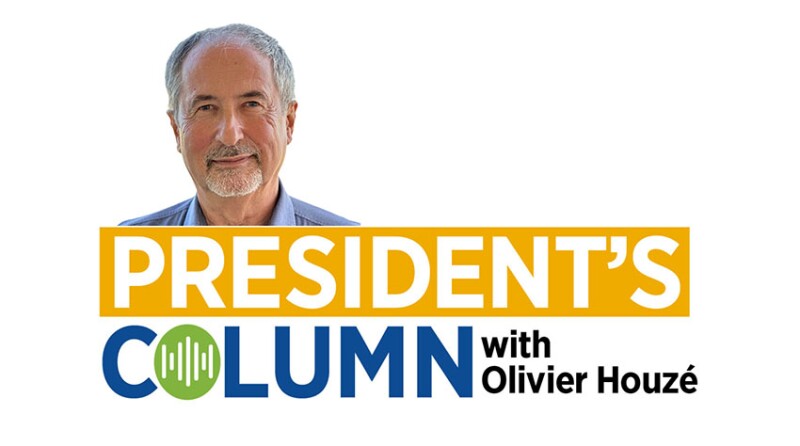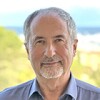For my Journal of Petroleum Technology (JPT) columns this year, I decided to deviate from the traditional format, which generally focuses on relatively short and specific topics. I opted to publish longer, and perhaps somewhat exhaustive, articles on key SPE topics where my objective was to provide members who could (and would) invest their time with an understanding of these issues at a level equivalent to what a board member might know. I promised you candor and transparency, and whether you like it or not, I have done my best to deliver.
For some topics, I also released a video, continuing the quite clever approach initiated by 2024 SPE President Terry Palisch, who last year delivered audio podcasts in conjunction with his monthly columns. In my case, I believe that presenting "vodcasts" (videos) worked to some extent. However, videos do not bring as much to exhaustive articles with graphs and relatively complex discussions requiring the reader to digest the information at their own pace. Based on this year's experience, the video format is more useful for shorter, more specific topics.
My five topical columns focused on:
(1) SPE's Role in Energy Transition
(2) SPE Finances
(3) SPE Governance
(4) Quality and Impact of SPE Publications
(5) SPE Membership
I took a pause preparing these columns when I ran out of topics I wanted to present to you, the members. Well, now there is another topic, one that I am sure will polarize traditionalists and progressives. Still, we need an overdue discussion about our name, the Society of Petroleum Engineers, as a technical society. In candor, I have long wanted to discuss our name, not for the sake of debate, but to define who we are, what we do, and what we may become.
In this column, I will start with an update on the five topics of my previous columns. This will be followed by (6) a report on two recent trips in Francophone Africa and Ukraine. The last section (7) of my column will be about our name. You may be tempted to jump straight to section (7) but there is a common thread between these seven items.
1. SPE's Role in Energy Transition
At the end of my October 2024 column, I suggested a classification of SPE’s activity to reflect the extension of our perimeter in the context of energy transition. I shamelessly plagiarized a tagline from a major service company, splitting SPE’s activity into the following segments:
- Core: our traditional oil and gas operations
- Low Carbon: anything related to the reduction of greenhouse gas emissions, and negative emissions with our work in CCS and CCUS
- New Energy: or more precisely, subsurface new energy, which covers all subsurface energy-related activities that are not in our core.
These classifications are summarized in the updated table (Fig. 1). For each classification, there is one primary activity (in bold) and then secondary activities. (Obviously), this table is not exhaustive.
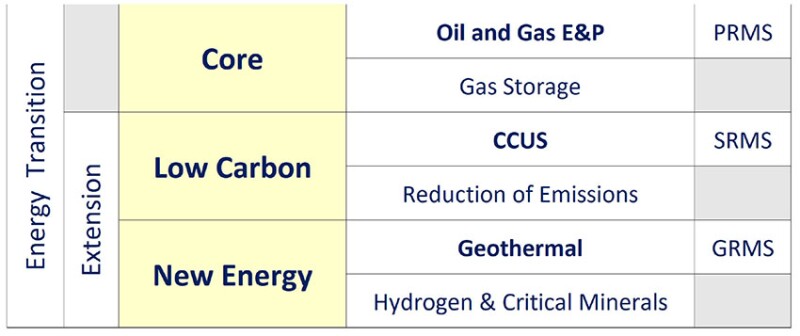
The "major classifications" core, low carbon, and new energy are shown on the left, where I provide groupings (e.g., energy transition and extension). On the right side, I have listed the "functional standards" that apply to each. Industry definitions for oil and gas reserves reside in the SPE Petroleum Resources Management System (PRMS) standard. SPE's equivalent work on CCUS is codified in the SPE CO2 Storage Resources Management System (SRMS) standard, and SPE's equivalent for geothermal energy will be established in the Geothermal Reserves Management System (GRMS) standard.
On 18 July 2025, the SPE Board of Directors formally approved the creation of three classifications: core, low carbon, and new energy.
These new SPE classifications are an engineer's approach to defining our space. These classifications do not carry any priorities regarding the relative importance of each, nor is there any "hidden agenda" where we will suddenly shift from our core oil and gas unless the SPE membership says differently. Further, these classifications will not be imposed on our membership, but rather, will be used when and where there is merit in doing so—e.g., event committees, technical sections, member initiatives, etc.
This classification has one technical objective and two communication purposes.
- It provides needed metrics. We need to know where we are and where we are going. This system is necessary to analyze the demographics of our membership, the allocation of our events, and the activities of our different regions, among other things. This system also applies to our finances, where these classifications will be added to our accounting system as an additional dimension of our analytical metrics.
- This classification system states unequivocally that oil and gas is and will remain our core focus in SPE.
- This classification system also clearly states that SPE is not only oil and gas, and that we will embrace both the challenges and opportunities of energy transition. From my recent experience visiting SPE sections and SPE student chapters, I have come to realize that energy transition is important to and aspirational for our young professionals everywhere.
Another comment on energy transition: I had the opportunity to visit the International Energy Agency (IEA) in Paris a few months ago, where we held an exhaustive working session, the outcome of which was cooperation with the IEA on six technical topics. This is one example among several interactions I had this year, where it was clear that the narrative towards our industry is changing, although very slowly.
2. SPE Finances
My November 2024 column detailed the evolution of our operational results since the 2020 COVID-19 pandemic and described the decisions taken by the board of directors during the fiscal year 2024 (FY24), including the closure of our physical office in London. These decisions were made after a comprehensive review of revenue, costs, and impact.
Despite these measures, by the end of FY24 (March 2024), we still had a baseline deficit of $2.5 million per year. The goals for FY25 and FY26 were to identify additional revenue to balance our operations. In addition, we eliminated our problematic 2-year budget cycle by changing our fiscal years from April to March to October to September. To do that, we had to create a 6-month transitional fiscal year, FY26A, from April to September 2025.
As shown in Fig. 2, in November 2024 (first column of net operating income, or NOI), we were planning to reach operational equilibrium (a breakeven budget) by September 2025 with a positive result when combining FY25 (anticipated deficit of $2.2 million) and the 6 months of FY26A (expected surplus of $2.4 million). In addition, starting with FY26B (October 2025 to September 2026), all following fiscal years would be slightly positive by design.
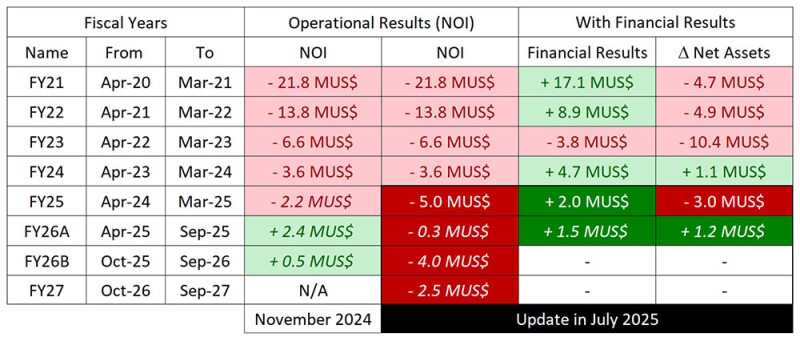
We also initiated a Global Sponsorship project, valued at $4 million per year, aimed at financing both traditional flagship programs (such as the Distinguished Lecturers) and new programs focused on our SPE young professionals. The initial feedback from our main stakeholders was positive, and we were expecting to start in mid-2025. This notional engagement was more than 6 months ago, which now seems like an eternity.
SPE's financial position deteriorated rapidly in the first quarter of 2025, primarily due to global political events that led to a decline in oil prices and an increase in the cost of doing business. The board realized the full extent of the problem during the second quarter of 2025. Given the oil price volatility and various geopolitical uncertainties in Q1 and Q2 of 2025, we observed a significant and immediate reduction in commitments to SPE events and activities, even from our most supportive stakeholders.
Financially, we have instantly returned to red, as shown in Fig. 2. The anticipated operational result for FY25 shifted from a $2.2 million deficit to a staggering $5 million deficit. For the short FY26A period, the expected surplus of $ 2.4 million became a minor deficit of $300,000. For FY26B, the expected surplus of $500,000 is now a deficit of $4 million. Lastly, our first estimate for FY27 is a deficit of $2.5 million. In oilfield language, after the 2015 downturn and the 2020 COVID-19 pandemic, we are now entering a 2025 downturn.
Looking back at FY25, we identified that $800,000 out of the $2.8 million additional deficit stemmed from elements that we could and should have anticipated, and this correction had to be applied to the subsequent years. The remaining corrections ($2 million for FY25, $1.9 million for FY26A, and $2.8 million for FY26B) are a direct result of the global financial situation over the first 6 months of 2025. The Global Sponsorship Program, approved by the board in April 2025, will not be launched until this crisis is over.
In terms of our net financial situation (net assets) shown in the last two columns of the table in Fig. 2, the situation has significantly improved due to the performance of our reserve funds. As with any investment, we cannot assume that such performance will always compensate for our operational deficits—for example, we can see in FY23 where the poor results of our reserve fund amplified our overall deficit for that year.
We cannot and will not wait and hope for better times. An operational deficit of $4 million in FY26B is simply not acceptable, and immediate action is required. We are currently making several difficult decisions. The board has already proposed some changes to the FY26B budget that will be approved on 18 September 2025. After this vote and before the 2025 ATCE in October, the SPE officers (the three presidents and the CEO) will present these decisions to the SPE membership in a joint communication in the October edition of JPT.
3. SPE Governance
We regularly seek members’ opinions through customer satisfaction surveys. At the end of my December 2024 column, I referred to a possible membership consultation that could have taken place in June 2025.
The project was presented at the January 2025 board meeting in Abu Dhabi. The proposed consultation was to ask up to four questions to members on key strategic issues. To materialize the decision and not just an opinion, we would ask members to cast a virtual vote for or against specific board resolutions as if they were sitting SPE Board members. Each question would be accompanied by a solid set of information equivalent to what board members need to review as pre-read. The four proposed questions were:
- If you were on the SPE Board, would you approve the current SPE policy/stance on climate change and energy transition?
- If you were on the SPE Board, would you approve the proof-of-concept (POC) for the direct election by SPE members of the 2028 President?
- If you were on the SPE Board, would you acknowledge that we have a serious problem with publication quality, and would you approve a large-scale project to improve the quality of our publications?
- If you were on the SPE Board, would you initiate a discussion within our SPE membership and with our main stakeholders regarding the change or the preservation of our name as the "Society of Petroleum Engineers," or SPE?
Following the January board meeting, two questions were assigned to each of the board committees (Technical Content and Membership). Two workgroups were created and later delivered their conclusions, rejecting their respective questions. At the April board meeting in Buenos Aires, both committees confirmed the workgroup conclusions, and the formal board meeting confirmed the rejection of all questions but remained open to member feedback. Consequently, there was no membership consultation in June 2025.
Running a consultation (or not) was the responsibility of the SPE Board to decide, and the rejection was clear. It is a personal disappointment, but my real concern is that we are not moving our governance even an inch.
One can argue, and it is true, that this has been our way of operating since 1957. So why should we change? Because precisely this is no longer 1957. I joined the board twice, 10 years apart. Nobody cared much about governance in 2012, before the first downturn in 2015. The situation has evolved, and members want to have their voice heard, and not only through surveys. We see it when discussing with our young professionals. We also saw it with the 2022 petition about the failed SPE-AAPG merger.
There are a few ways to bring the statutory preeminence of SPE membership over SPE leadership into reality. We can open board nominations to vote, as some sister societies do, or we can ask our members to decide on key issues regularly. We could do both, but one would be a good start. We have delivered none so far.
Our board remains a self-replicating body. Members nominate candidates, but most of the election process, short of a petition, is controlled by the board. As detailed in my December column, the process has merits, including the serious vetting of candidates, a constant effort to balance the board's demographics, and the occasional introduction of newcomers. But keeping the current process would only be acceptable if we opened some key decisions to members.
The consultation project aimed to address four key topics: energy transition, board election, publication quality, and our name. The idea was to ask members questions about substantial issues, not the Pantone color of the SPE logo.
In the absence of any practical means for members to express their opinions, concerns, or disagreements in an ‘executive’ way (not just a survey), the only option available today is to trigger a vote via a petition process which was not designed for that and, as we saw in 2022, tends to be confrontational. I think we can and should do better.
4. Quality and Impact of SPE Publications
My January 2025 column on the quality of our publication was among the most read online JPT columns. One caveat is that we will never know the readership statistics for columns published during the print-only era.
However, it makes sense that such a topic would garner attention in a technical society. I also received considerable direct feedback—two cases were negative, all the others were positive, with many suggestions shared.
Following the publication of this column, an SPE Board workgroup was established, comprising invited non-board members. The workgroup identified several issues and provided initial recommendations in a report presented to the Technical Content Committee at the July 2025 (virtual) board meeting. This effort remains a work in progress, and I encourage my successors to continue this workgroup and to share its work and conclusions broadly with the SPE membership.
5. The SPE Membership
My February 2025 column was dedicated to SPE membership, and in Fig. 3 we observe a record growth between 2005 and 2015, with a peak at just below 100,000 professional members, followed by a two-stage decrease with the 2015 downturn and the 2020 COVID-19 pandemic, stabilizing to an average of about 68,000 professional members over the past 4 years.
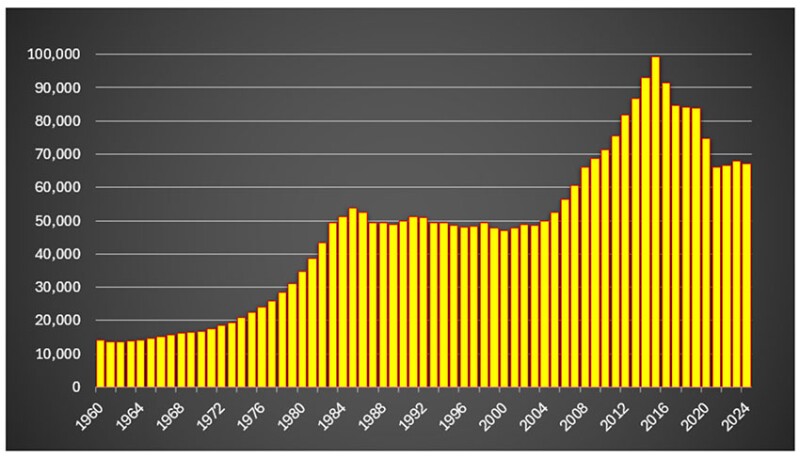
Before we investigate regional and demographic-specific member numbers, we must qualify the data we use. As in any interpretation process, ignoring the limitations of the data can bias both the interpretation and any conclusions we draw. We all know this, but I just want to be sure everyone understands that my comments are made with reading glasses, not a microscope. So here we go.
- Our professional member numbers are actual numbers (i.e., people who are SPE members).
- Our student member numbers are also actual numbers, but recall that student membership has been free, courtesy of a longstanding grant from Chevron.
- SPE member counts are the number of professionals multiplied by a “market share” factor corresponding to our ability to convert these professionals into members. As we do not know either of these two numbers, we may face two pitfalls:
- Extrapolating SPE membership numbers to the industry at large carries the assumption that our market share is constant (it is not; market share varies by region and by demographic groups, and it also varies with time)
- When considering ways to increase membership, we must not forget that we have no control over the number of professionals our stakeholders hire and fire.
- We rely on regional and demographic information provided by our members, but only 80% of members provide this information, which is a very high percentage. We assume that these missing 20% do not introduce demographic or regional bias.
Fig. 4 adds regional information to Fig. 3. The bars are now differentiated by region, except before 2010, when only the US was differentiated. As a reminder, a member's regional designation does not necessarily represent their nationality, but the region where this member is registered. In Fig. 5, we present the same data in percentage terms.
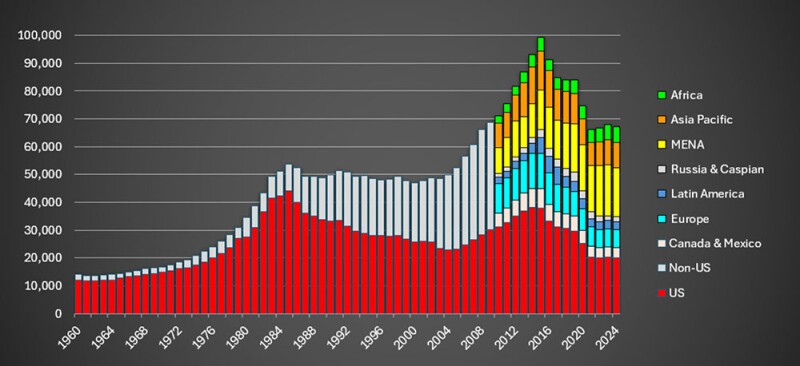
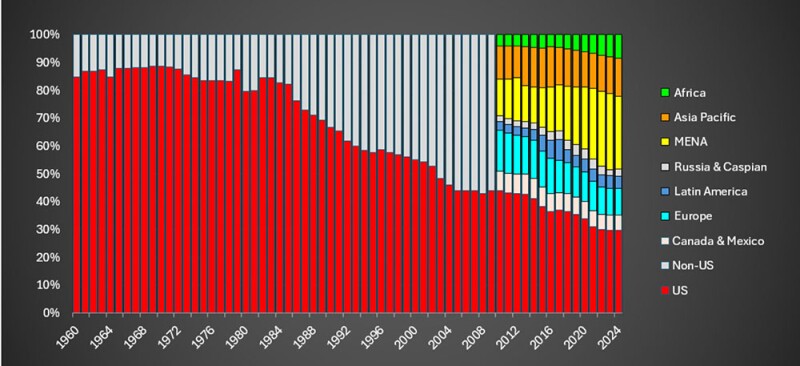
As already noted in my February column, there is this transition from an 85% US-based society 40 years ago to 70% non-US membership today (Fig. 5). In absolute terms (Fig. 4), the US professional membership is back to its 1976 level (20,000).
We observe a comparable reduction in Europe, Canada, and Mexico. Latin America and the Russia and the Caspian regions remain below their higher potential levels.
In contrast, the Middle East and North Africa and Africa regions have both grown consistently since 2010, and the Asia Pacific region has maintained a relatively stable membership. In fact, the Africa region experienced record membership numbers in 2024.
Starting with Fig. 6, we now focus on the age demographics from the final number of our 2024 membership. The x-axis is the year of birth of the members, and the y-axis is the number of active professional members born in this year. Young professionals are found on the right part of the plot, meaning the members born in 1990 or later. This was already presented, albeit in a slightly different form, in my February 2025 JPT column.
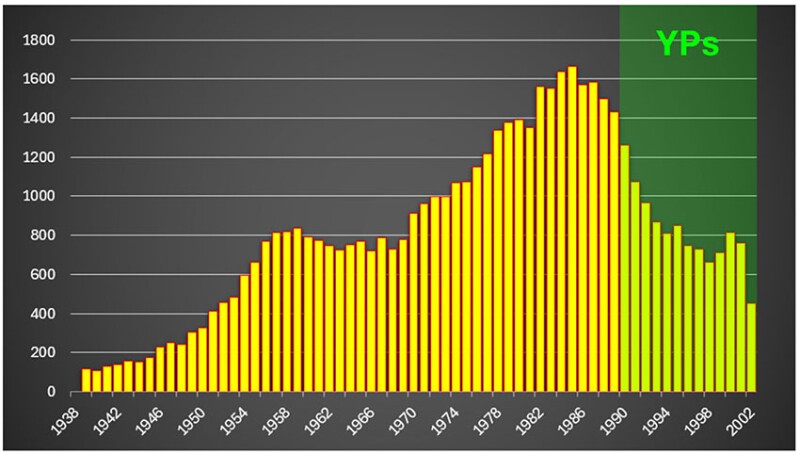
The number of young professionals age 30 and under has decreased significantly—by 60% over the past decade—from around 18,000 in 2015 (not shown) to under 7,000 in 2024. Those young professionals in the 31–35 age range have seen a similar decline, falling 56% from 12,842 in 2015 to 5,599 in 2024.
Regional demographics are presented in Fig. 7. Clearly, the US, Canada, Mexico, Europe, Latin America, and Russia and the Caspian young professional membership percentages have experienced a significant decline for those born since 1990. There are several reasons that explain this, but regardless, this is a truly exceptional and (frightening) trend.
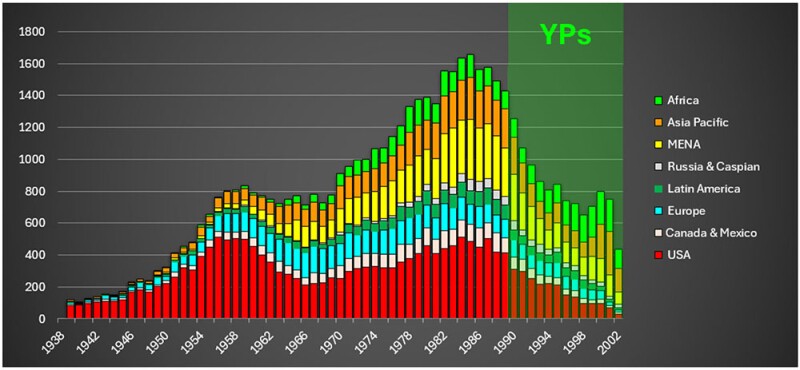
The data presented in Fig. 7 are now presented in Fig. 8 as a percentage of the total for a given year of birth. The effect is equally striking, but perhaps more impactful, as one can see the significance of membership by region.
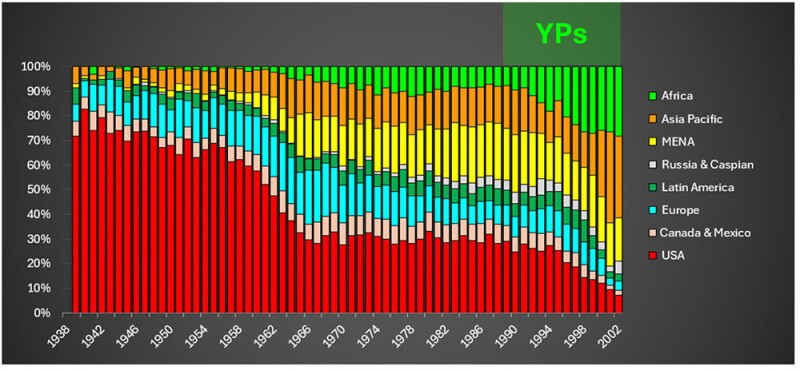
For those members born since 1990 in the US, Canada, Mexico, Europe, Latin America, and Russia and the Caspian, these trends appear historically irreversible. This is a plot that must be discussed and considered in terms of our "transition" of membership to the Middle East, North Africa, Asia Pacific, and Africa regions.
In Fig. 9, the yearly data presented in Fig. 8 are now merged and grouped by age. The first five groups, finishing with the young professionals, are complementary and mutually exclusive. The last age group is a subset of the young professional group, comprising only members who are 30 years old or younger.
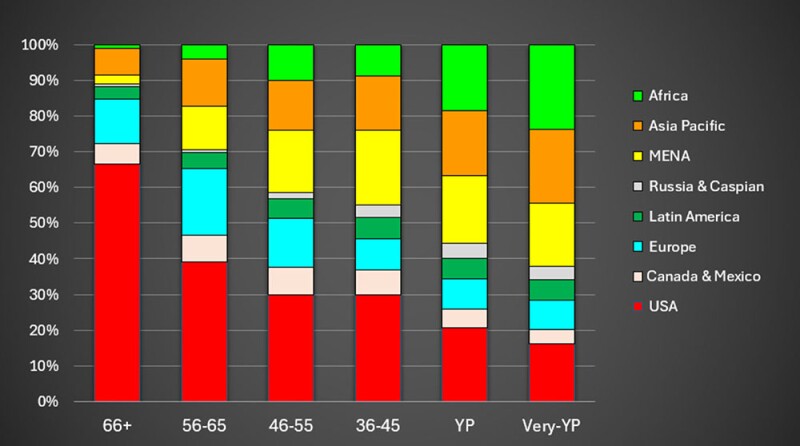
This graph visually confirms the considerable demographic shift that has taken place in our industry, not only over the past 10 years.
One could infer many conclusions from these data, but the reality, regardless of the interpretation, is that we must conclude that SPE membership is in transition. Is this a threat, an opportunity, or both?
I believe that future discussions must consider these factors in a realistic and business-focused manner. As the saying goes, "Just because we are old, we are not obsolete," but SPE must focus on its age and missions without delay and without being tied to historical perspectives.
Last point: I believe we all welcome the growth of Middle East, North Africa, Asia Pacific, and Africa as a reservoir of talents for the future. We should not give up on North America and Europe, and we have some catching up to do with Latin America and the Caspian region (Russia remains a special case in the current context).
6. Tours in Francophone Africa and Ukraine
Even before you start your year as SPE President, your schedule is already full of mandatory functions (SPE Board meetings, weekly functional meetings, major conferences, meetings with staff, member committees, etc.).
My presidential year is from September 2024 to October 2025, and like every other SPE President, there are sometimes overlaps and impossibilities—like a request to be in one place one day, and 10,000 miles away the next day. It happens a lot. When this happens, the active president calls the past and incoming presidents for help.
The physical location of the three presidents is also important. For cost and time, it does not make sense to cross an ocean when another president is available on the other side. And to be sure, when you have an invitation in-person or online, large or small, it is unbelievably challenging to say no.
Long story short, the SPE President's schedule is always busy, but occasionally you add your own tasks for personal reasons. In my case, these were tours in Francophone Africa (May) and Ukraine (June). Incidentally, Africa and Ukraine are regions where SPE membership is booming against the general trend, especially for young professionals.
Africa
I was born in Abidjan a few months before Côte d’Ivoire became independent from France. I am, technically, the first SPE President with a Francophone sub-Saharan Africa background. When I told this to Riverson Oppong, our Regional Director for Africa, we agreed to visit all these Francophone countries in 2025. The decision was made easier by the fact that, to our knowledge, no active president had ever visited any of these countries.
A first trip in the last 2 weeks of May 2025 took us to Chad, Cameroon, Gabon, and Congo, ending with the first African Technology Conference, or ATC, in (Anglophone) Tanzania. While finishing this column, I am starting my second trip, which takes us to Côte d’Ivoire and Sénégal, with other stops in (Anglophone) Ghana, and of course, we have a stop in Nigeria for the 2025 NAICE meeting.
As seen in the previous section on membership, Africa is a very dynamic SPE region. It is the only region where the record for the highest SPE professional membership was last year (2024), and not 2015. All the sections I visited were in a bit of sleep mode after the pandemic, but in the past couple of years, section chairs and boards have been both very active and very successful in recharging the SPE sections in the Africa region. I should also mention that in every country I visited, with local stakeholders, all these companies expressed a willingness to support the SPE sections in their area.
The welcome was amazing at every stop we made on our May 2025 trip. There is energy, even hunger, in these SPE sections where both SPE professional and student members were happy to see both their SPE President and their SPE Regional Director.
As an introduction to my talk on energy transition, I like to refer to the two questions a student or a young professional must answer before deciding to join or remain in our industry: the selfish question: "Is there a career for me?" and the altruistic question "Am I on the right side of history?" where the second question naturally refers to energy transition and the perception of the role of our industry in this energy transition.
To be blunt, in Europe, the second question is always the focus, and frankly, I was expecting that in Africa, particularly with the urgent need for cheap and sustainable energy to reach living standards, this question would be on the back burner. From all the interactions I had with students and young professionals during my trip to Africa, I realized how wrong I had been. For the students and young professionals I encountered in Africa, the question of energy transition is absolutely top-of-mind. There were many questions and comments on the topic—and we should not make assumptions about energy transition in general, and for young professionals from emerging countries in particular.
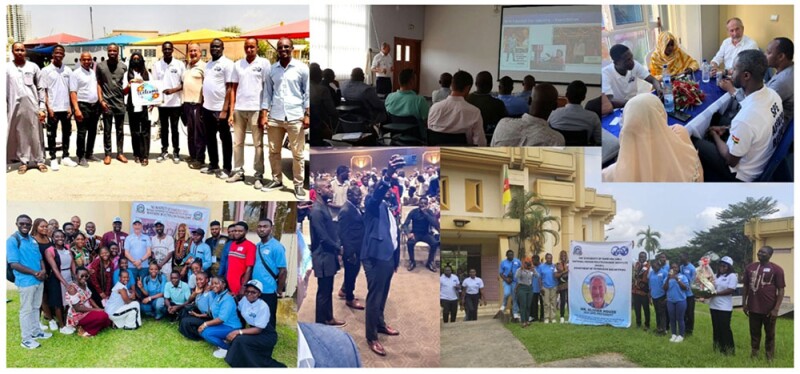
Ukraine
As a US-based organization, SPE complies with the sanction regimes resulting from the conflict in Ukraine. Beyond this, as a professional society operating in 146 countries and one that stands on both sides of many geopolitical divides, SPE should not and does not take a position on any conflict. This necessity of neutrality can be frustrating on a personal basis, but it is essential.
However, SPE supports its members everywhere and unconditionally. The visit to Ukraine by an active SPE president was an expression of this support, nothing more and nothing less. This message is extended to all our members, wherever they live, who work and conduct SPE activities in environments ranging from tense to truly dangerous. These members face daily challenges that are slightly more substantial than having an abstract rejected or missing a flight connection.
I may be the first active president to do this. Still, I follow 2021 SPE President Tom Blasingame, who came in 2023 after leaving the board, and Pierre Emmanuel d'Huart, our Regional Director for Europe, who visited Ukraine last year.
There are no longer air connections to Ukraine, and you must go there by train, bus, or car via neighboring countries. In the wake of the successful 2025 EuropEC in Vienna, I took a day train on 13 June 2025 from Vienna to Chop, a border town, followed by a night train from Chop to Kyiv, for a total of 23 hours travel time. At the Kyiv railway station, I was welcomed by Yurii Moroz, SPE Ukraine section chair, who took care of me in the first segment in Kyiv, then Poltava, and then back to Kyiv. The second segment took me to Ivano-Frankivsk and Lviv before crossing the Polish border to Krakow and back home to France. Many of our SPE professional and student members took care of me during this trip, and I cannot thank them all individually, but they know who they are, and they know my sincerest gratitude for their continuing service to SPE.
Unexpectedly, each stop started with a tourist tour of the town, as if everything was normal. Sometimes, we would casually pass by recently damaged buildings with a misleading appearance of normality. There is a sort of cognitive dissonance in all this. The nights, when most attacks take place, are more complicated, but I will not bother you with the details, and it is difficult to share, anyway. In short, whenever there is a night of intense bombing, on the following day, people are not necessarily afraid—they are just tired, sometimes exhausted, but they carry on as if it were all just "normal."
Each stop was an occasion to visit members, students, and stakeholders. I also visited two very different, but equally impressive, universities in Poltava and Ivano-Frankivsk.
Everyone I met seemed genuinely happy that I came to visit. Although the situation differs from that in Africa, in both cases, it is the kind of reaction that gives you the impression that you are making a symbolic and actual difference.
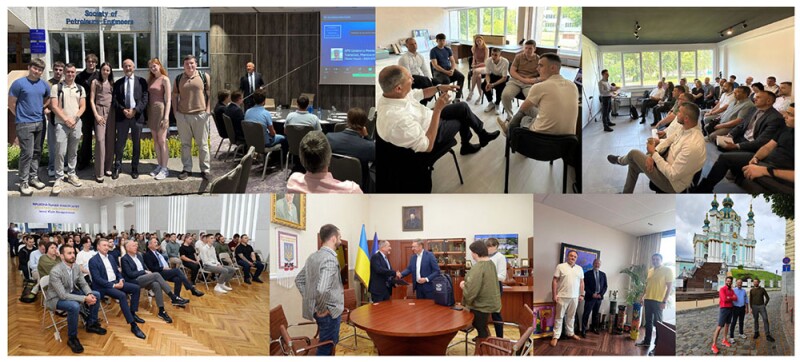
When you consider an SPE section in a country at war, you may believe that the objective for such a section is to survive by sustaining minimal activity until the end of the conflict. It is the opposite for the Central Ukraine section. At the beginning of the war (February 2022), it had 120 professional members and 350 student members, while at the time of my visit in June, this section had 300 professional members and 870 student members. I was told that this section gained 80 more members since my visit—in just 1 month. Clearly, the credit must be given to the section leadership team, but it could be interpreted that these difficult conditions provide these people with the motivation to serve and be served by SPE. At least that's my perspective, having been there.
In closing this discussion, I must reiterate that SPE must serve all its members without bias—it’s a duty of care that SPE has and must maintain. There is no symmetry here, but it also applies to our Russian members that I will be visiting at the end of August.
7. What’s in a Name?
On my very first function back to the board in 2023, the very first request I had right after my very first talk was from a young professional who asked me if I could “please remove the P from SPE because it is killing us.” That was quite a start! The message was clear, but this was Europe, where public acceptance of our industry is at its lowest. Though we sympathize with their problems, changing our global name and hiding our oil and gas core activity for local greenwashing purposes is not and should not be on the table.
However, the question of the evolution of our name and its adaptation to our new reality is relevant. Many of our stakeholders have already done so when needed. They continue to explore and produce, with maybe a lower profile in ‘unfriendly’ areas, but they have also widened their scope and called themselves energy companies, not just oil and gas.
Some universities have cancelled and banned oil and gas altogether in a process that may turn out to be a long-term self-inflicted wound. However, many others have adapted their name to a wider range of energy sectors while keeping their oil and gas curriculum. The last example I had was during my visit to the Ivano-Frankivsk University in Ukraine (see section 6), where they now extend their curriculum to CCUS and geothermal energy and call the resulting perimeter energy. They have, in a way, switched to a core—low carbon—new energy curriculum (see section 1).
Is there a bit of greenwashing in the process? Well, maybe, but only as an aside. Universities in Ukraine have other fish to fry, and still, they move on. The first reason is that an extended curriculum makes sense technically. But another reason is that students and young professionals, even in war-torn Ukraine and growth-hungry Africa, wish to be on the right side of history and appreciate that they are part of a larger, longer-term, and more attractive story they can identify with.
So why have we, as SPE, been avoiding this discussion for so many years? Well, we know very well why: fears. Fear that raising the issue could ignite a ‘civil war’ and potentially split our society; fear that it could resurrect and amplify the controversies that followed the SPE-AAPG merger project; fear that we are collectively unable to have a calm and respectful discussion on such a sensitive topic; and fear that many of my generation would flag any name change as treason.
I think these fears are overblown, but they are not unjustified, and there is always a risk. The problem is that it has become an excuse to indefinitely postpone the inevitable, arguing that it is too early and that we are not ready. Too early, really? Is it too early to break the taboo and start a discussion, even if the outcome is no change or not yet?
Our young membership numbers are bleeding (see section 5). It would be ridiculous to assert that our name is the culprit, but it certainly does not help, and what helps even less is our apparent inability to evolve on this sort of issue.
In the past 2 years, I have had several conversations with young professionals and students on the subject, in many different regions. Most of them actively wished for a name change, and not even one seriously opposed it. These are only data points, but I do not think there is much doubt about where our young professionals stand on this issue.
Now, let me provide a list of elements that may be useful if we decide at last to enter a debate on our name. If we indeed enter this debate, it will also be important to present all elements in favor of the status quo.
The two problems with the ‘P’ and the problem with the ‘E’
A bit of history serves as context for our name. The American Institute of Mining Engineers (AIME) was incorporated in the US in 1871. In 1913, AIME created an Oil & Gas Committee, which developed over the following decades. This committee created the first Fall Meeting (now called ATCE) in 1924 and the first edition of JPT in 1949. The Society of Petroleum Engineers (SPE) was formally incorporated in 1957 and became an independent organization in 1985.
For a long time, our name perfectly fit its purpose. SPE members were almost exclusively petroleum engineers, and the name did not bring serious public perception issues. This has changed in the past 10 years, as we saw the growth of two issues with the ‘P’ and one issue with the ‘E’. I doubt anything here is a surprise to any of you reading this article.
The first problem with the ‘P’ (Petroleum)
The word petroleum is a public relations issue, and it relates to the negative image of the oil and gas industry in many places. This problem predates the climate crisis, as there were many reasons, both fair and unfair, for our industry to be unpopular: oil spills and other spectacular accidents with environmental consequences, accusations of extreme lobbying, political interference, being the flagship of hard-core capitalism, etc.
This public relations problem has taken another dimension in the context of the climate crisis. Many consider us as the main problem, conveniently ignoring what our industry has brought and still brings to mankind, with no credible short-term alternative. No need to develop it, and I would just highly recommend any book on the topic by Vaclav Smil.
This public relations issue is on everyone’s mind, and it badly hurts SPE in many places, not only in Europe. However, I believe that public relations is the weakest argument for name change. It would be disingenuous to change our name only for this, though it would also be hypocritical to pretend that we do not have a problem.
The second problem with the ‘P’ (Petroleum)
The P is no longer accurate. It does not mirror our extended perimeter. This is already detailed in section 1 above. In a nutshell, the truth about what we do beyond our core activity is simply exciting, as we leverage 150 years of experience in oil and gas to mitigate CO2 emissions and produce “subsurface new energy.”
We do not know exactly how much and how long we will produce oil and gas, but short of a major technical breakthrough, it will be many decades. But beyond oil and gas, we can expect that mankind will keep an interest in messing with fluids in the deep underground (whenever Darcy’s law or a nonlinear version of it applies, basically), and this will remain the territory of SPE or whatever technical society replaces it.
It may be about time to address this growing inaccuracy in our name.
The problem with the ‘E’ (Engineers)
It is also an issue of accuracy. A growing fraction of members are not petroleum engineers, nor are they engineers. This is mainly due to the growing number of ‘horizontal’ technical disciplines that do not require a petroleum engineering degree. This is the case of assets management, data science, and HSE.
The Society for Professionals in Energy
To the best of our knowledge, the possibility of this name change came 15 years ago. Drawing on the principle of “giving to Caesar what belongs to Caesar,” the idea of a “Society for Professionals in Energy” originated from the 2010 SPE President Behrooz Fattahi (Source: 2023 SPE President Med Kamal).
At that time, membership was growing exponentially, so this was certainly not a defensive idea. In 2010, SPE’s influence was accelerating, and the ambition was to evolve to the next level.
This idea was revived by the 2018 SPE President Darcy Spady, under very different conditions. We were in the wake of the 2015 downturn, and the pushback against our industry, largely reflected in public opinion, was starting to be felt.
In October 2018, the brand "Society for Professionals in Energy" was registered as a trademark in various countries. It was not introduced as a name change, though it may have crossed some minds. The initial idea was to use this brand as a tagline for events that went beyond petroleum engineering. This branding was used only once at the SPE Middle East Energy Summit in Bahrain, March 2019.
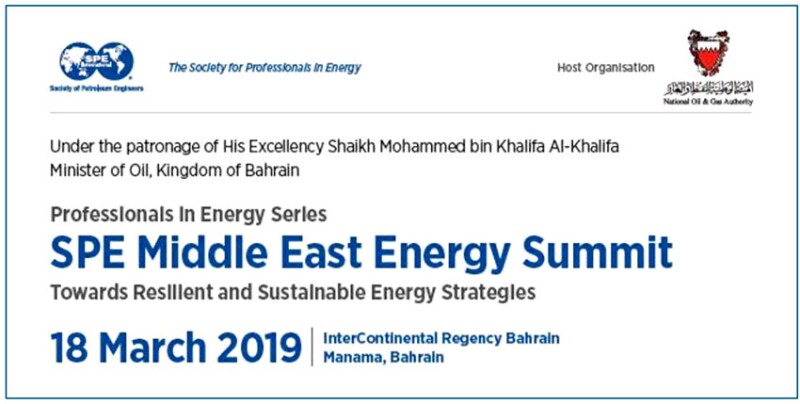
The "Society of Professionals in Energy" branding was also floated in the context of the SPE-AAPG merger project, but it was ruled out even before the global project collapsed. For years, the trademark was discreetly kept on the SPE web page listing its brand names. Such publication was needed to justify usage and renew the trademark (just in case it was ever to be used).
In 2024, the Society for Professionals in Energy branding was spotted by the Aberdeen Section. The information quickly spread. The Aberdeen Section requested to use it for geothermal, hydrogen, CCUS, and other net-zero events. The request was accompanied by the remark that an SPE name change was overdue.
At the European Section Officers meeting, all sections asked if they could use the Society for Professionals in Energy logo, insisting that they needed to brand themselves without “Petroleum.” The German Section noted that the term “petroleum” was closing a lot of doors and indicated that they were considering renaming themselves “Deutsche Sektion der Society for Professionals in Energy (GSSPE) e. V.”
Finally, a formal request was made in the context of the launch of EuropEC 2025, a critical edition of the event. All this was European and was clearly related to our first problem with the “P.”
The SPE officers asked everybody to hold their fire, as this is a most delicate matter. The initial request was clearly bottom-up, but any such authorization would set a precedent and could be interpreted as a top-down attempt to change the name. Any major top-down initiative could be perceived as inherently negative, even 3 years after the perceived top-down proposal of an SPE-AAPG merger and the following election petition that resulted.
The issue was presented to the Technical Content Committee at the April 2024 SPE Board meeting in Perth, and a branding workgroup was subsequently established. The workgroup prepared a working paper for the July 2024 board meeting in Stavanger. The SPE Board quickly agreed that the Society for Professionals in Energy branding must be discontinued, as this branding would imply a name change. The workgroup needed to find a new tagline, not a new name.
Solutions. People. Energy.
Many ideas were circulated. Some options did not correspond to the SPE acronym, some kept the letters but in a different order, and some kept the SPE acronym intact. At one point, the proposal Subsurface Professionals in Energy gained traction, which was a more accurate representation of our mission and activities, and addressed all P and E issues while keeping the SPE acronym. But the problem was exactly that—this looked too much like a name change.
Solutions. People. Energy. came at the last minute and we believed that we had probably found our tagline. The tagline refers to values rather than a description of what we do. It was unambiguously a tagline and not a candidate for a new name. I believe we must credit our CEO, Simon Seaton, for this one.
The tagline was selected by the workgroup, approved by the board, and formally announced at the 2024 EuropEC as the tagline chosen for the next (2025) version of the event.
Although we were cautious (and a bit worried), the tagline was well received, and it spread extremely fast and well beyond Europe, including in places where we were expecting pushbacks. It is so successful and well-accepted that it has become the theme of the 2025 ATCE to be held in Houston in October.
So…
In the absence of a member consultation on this topic, discussions about our name will need to be initiated by the members. This may be the opportunity for an actual bottom-up process. I expect young professionals to jump to the occasion, considering it is a topic they tend to bring up without prompting. However, I do not see why any interested member, regardless of their age, would not relish the debate.
The topic is important; some may be passionate about it, but it does not mean it has to be confrontational. The hard exchanges during the petition episode happened in a very specific context and are not a template for future debates. Most members "will agree to disagree," and will accept the outcome of a vote if (and when) this happens.
Please do not hesitate to share your thoughts with me at president@spe.org.
8. Conclusion
I have 10 weeks left before I close my term and hand the gavel to 2026 SPE President Jennifer Miskimins , at the 2025 ATCE in Houston. Between now and then, I have 12 more countries to visit, and this should be it. My goal was to retire from my year exhausted, and I am well on my way to achieving (at least) that goal.
Fun fact: Next year will be my last on the SPE Board, and as Past President, I will chair the Finance Committee, which may have been the most challenging job on the SPE Board in the past 10 years. And make no mistake, we are in tough financial times again.
When I started my year in September 2024, there was hope that we had reached the end of the “incredibly shrinking SPE” scenario—specifically that in 2024, we made what we hoped would be the last set of cost reductions so that at last, after 10 years of struggle, we would achieve true operational balance. The next target was to go on the offensive, creating new programs financed not by SPE member events, but by a new program of global sponsorship that had certainly captured the attention of our stakeholders prior to this latest industry slowdown. The financial challenges we have experienced in the last few months are unwelcome, but we must live with it and face yet another SPE "shrinkage."
One positive element that was not discussed in my columns relates to generative AI, with the first release of our Energy LLM, a large language model developed in cooperation with Aramco and I2K Connect using SPE copyrighted materials. This should become a new service to SPE members by 2027, but now it is a source of revenue through the licensing of our copyrights for generative AI purposes. This work has been and will be the subject of various SPE communications, and it is proceeding well.
Counterintuitively, I am not worried about our long-term finances. We know what we need to do, though we need to act quickly and make difficult decisions. We should rebound quickly and then resume the development projects we had to postpone this year. We should be able to weather this storm.
My main concern right now is our demographics—we have a "time bomb" of fewer young members and more stress on recruiting and retaining membership in a challenging environment. Some of the problems come from the policy of our stakeholders, which, clearly, we do not control. Hope is not a battle plan. If we engage, we can influence.
As a close, I would like to state that I believe in an evolution of our governance, and a need to address "traditional" elements like our name. Both are challenges, if not impediments, for our younger members. At this point, I can only ask for a discussion on these challenges. I hope others can see this as a priority as well.
None of this will be easy, but if life was easy it would be boring … Now back to work!

